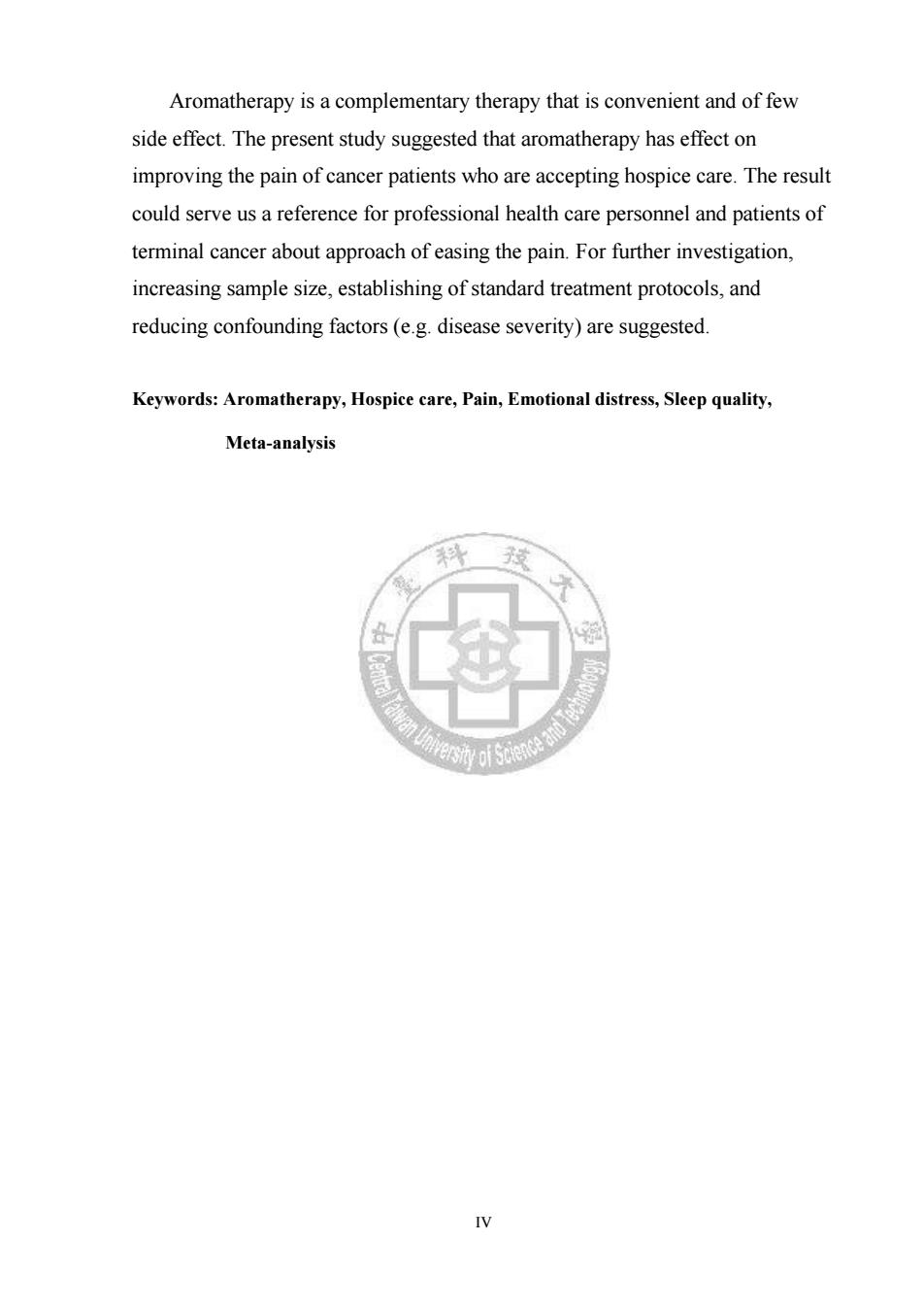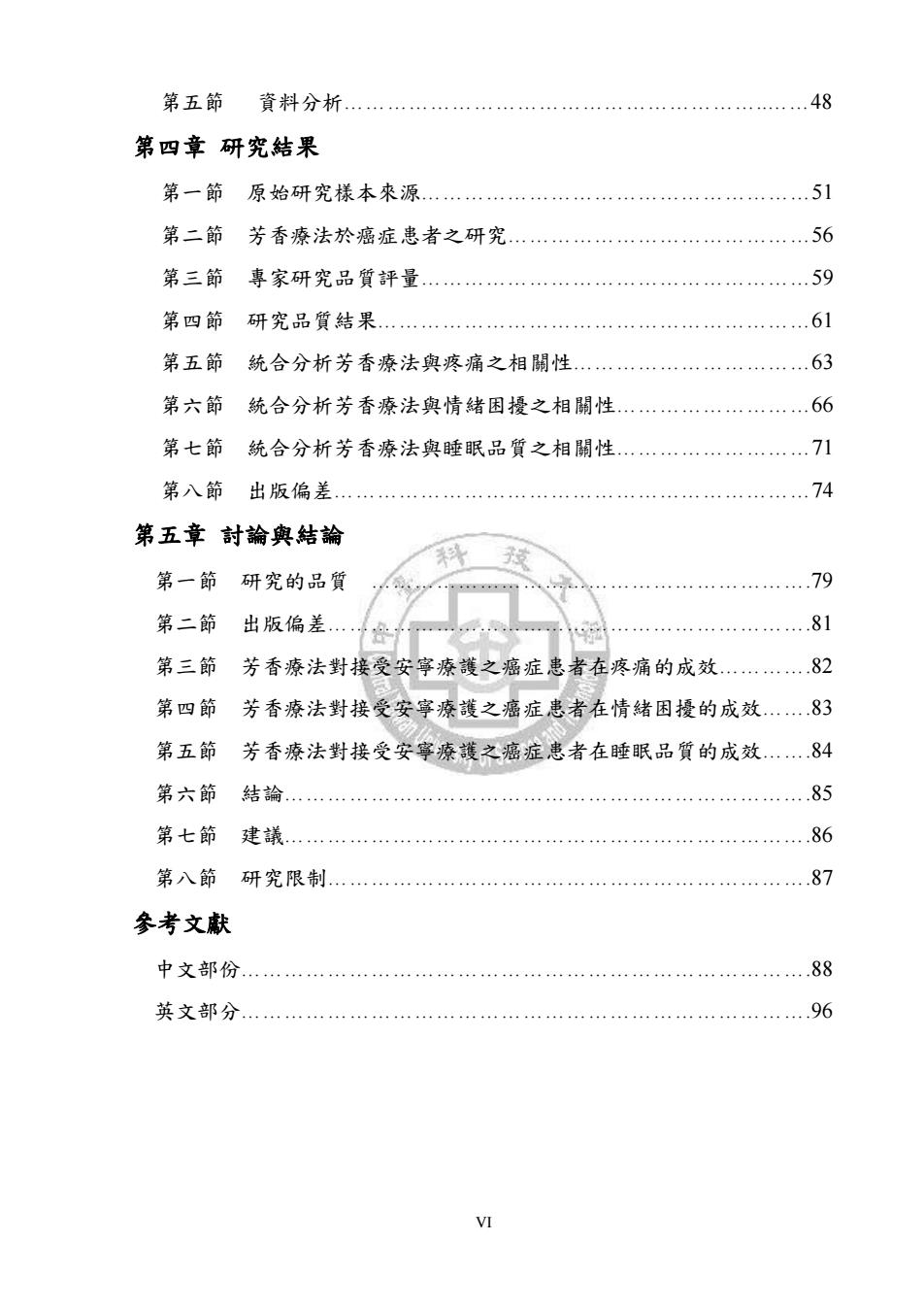
Aromatherapy for Pain,Emotional Distress and Sleep Quality in Cancer Patients Receiving Hospice Care:A Meta-Analysis Abstract Cancer has been the first of the top ten leading causes of deaths in Taiwan for thirty years.During the sickness,patients are accompanied not only by the physiological discomforts but also the psychological disturbances.Therefore, other than traditional medical therapies,complementary therapies are also widely accepted.Aromatherapy is now one of the mostly used therapies in palliative care unit.The present study explored the effect of aromatherapy on pain,emotional distress and sleeping quality in cancer patients receiving hospice care.A systematic review was conducted by using keywords such as ■ aromatherapy,hospice care,pain,emotional distress and sleeping quality to search related literatures at databases including CINAHL MEDLINE The Cochrane Library、CEPs、GRB、PerioPath:Index to Taiwan Periodical Literature System,National Digital Library of Theses and Dissertations in Taiwan,etc. Literautres were selected following the inclusion and exclusion criteria,and then were evaluated by Cochrane Collaboration's Tool for Assessing Risk of Bias,and those with moderate research quality were further analyzed by statistical software Comprehensive Meta-Analysis version 2.0 to evaluate the effect of aromatherapy.The results revealed that aromatherapy had moderate effect on improving the pain of cancer patients accepting hospice care,however, the effects on emotional distress and sleeping quality were not statistically significant,the effect size were 0.539(95%CI:0.173~0.906),-0.198(95%CI: -1.045~0.649),0.621(95%CI:-0.498~1.739),respectively. Ⅲ
III Aromatherapy for Pain, Emotional Distress and Sleep Quality in Cancer Patients Receiving Hospice Care: A Meta-Analysis Abstract Cancer has been the first of the top ten leading causes of deaths in Taiwan for thirty years. During the sickness, patients are accompanied not only by the physiological discomforts but also the psychological disturbances. Therefore, other than traditional medical therapies, complementary therapies are also widely accepted. Aromatherapy is now one of the mostly used therapies in palliative care unit. The present study explored the effect of aromatherapy on pain, emotional distress and sleeping quality in cancer patients receiving hospice care. A systematic review was conducted by using keywords such as aromatherapy, hospice care, pain, emotional distress and sleeping quality to search related literatures at databases including CINAHL、MEDLINE、The Cochrane Library、CEPS、GRB、PerioPath: Index to Taiwan Periodical Literature System, National Digital Library of Theses and Dissertations in Taiwan, etc. Literautres were selected following the inclusion and exclusion criteria, and then were evaluated by Cochrane Collaboration’s Tool for Assessing Risk of Bias, and those with moderate research quality were further analyzed by statistical software Comprehensive Meta-Analysis version 2.0 to evaluate the effect of aromatherapy. The results revealed that aromatherapy had moderate effect on improving the pain of cancer patients accepting hospice care, however, the effects on emotional distress and sleeping quality were not statistically significant, the effect size were 0.539 (95% CI: 0.173~ 0.906), -0.198 (95% CI: -1.045~ 0.649), 0.621 (95% CI: -0.498~ 1.739), respectively

Aromatherapy is a complementary therapy that is convenient and of few side effect.The present study suggested that aromatherapy has effect on improving the pain of cancer patients who are accepting hospice care.The result could serve us a reference for professional health care personnel and patients of terminal cancer about approach of easing the pain.For further investigation, increasing sample size,establishing of standard treatment protocols,and reducing confounding factors (e.g.disease severity)are suggested. Keywords:Aromatherapy,Hospice care,Pain,Emotional distress,Sleep quality, Meta-analysis 1he75e99形00 IV
IV Aromatherapy is a complementary therapy that is convenient and of few side effect. The present study suggested that aromatherapy has effect on improving the pain of cancer patients who are accepting hospice care. The result could serve us a reference for professional health care personnel and patients of terminal cancer about approach of easing the pain. For further investigation, increasing sample size, establishing of standard treatment protocols, and reducing confounding factors (e.g. disease severity) are suggested. Keywords: Aromatherapy, Hospice care, Pain, Emotional distress, Sleep quality, Meta-analysis

目錄 致謝… 中文摘要… Π 英文摘要…顶 目錄… 圖目錄… …Ⅷ 表目錄… …区 第一章緒論 第一節 研究背景… 第二節 研究動機與目的 第三節 研究問題… 第四節 名詞界定… 5 第二章文獻查證 第一節 癌症介绍 …7 第二節 安寧療護…… 13 第三節 .16 香療法………… 第四節 統合分析.…… .30 第三章研究方法 第一節 研究過程..…… ….41 第二節 資料搜尋與資料篩選 .43 第三節 研究工具及登錄信度 .45 第四節 研究品質評估 .46
V 目錄 致謝…………………………………………………………………Ι 中文摘要……………………………………………………………Π 英文摘要……………………………………………………………Ⅲ 目錄…………………………………………………………………Ⅴ 圖目錄………………………………………………………………Ⅷ 表目錄………………………………………………………………Ⅸ 第一章 緒論 第一節 研究背景…………………………………………………………1 第二節 研究動機與目的…………………………………………………2 第三節 研究問題…………………………………………………………4 第四節 名詞界定…………………………………………………………5 第二章 文獻查證 第一節 癌症介紹…………………………………………………………7 第二節 安寧療護………………………………………………………...13 第三節 芳香療法………………………………………………………...16 第四節 統合分析………………………………………………………...30 第三章 研究方法 第一節 研究過程………………………………………………………..41 第二節 資料搜尋與資料篩選…………………………………………..43 第三節 研究工具及登錄信度…………………………………………..45 第四節 研究品質評估............…………………………………………..46

第五節 資料分析… 48 第四章研究結果 第一節原始研究樣本來源 51 第二節芳香療法於癌症患者之研究.… 56 第三節專家研究品質評量……… 59 第四節研究品質結果..… 61 第五節統合分析芳香療法與疼痛之相關性 。。。 63 第六節統合分析芳香療法奥情绪困擾之相關性… 66 第七節統合分析芳香療法與睡眠品質之相關性 ..71 第八節出版偏差.… 74 第五章討論與結論 第一節研究的品質 79 第二節出版偏差. 81 第三節芳香療法對接受安寧療護之癌症患者在疼痛的成效 82 第四節芳香療法對接受安寧療護之癌症患者在情绪困擾的成效83 第五節芳香療法對接受安寧療護之癌症患者在睡眠品質的成效..84 第六節结論……… 85 第七節建議… 86 第八節研究限制… 4。。4。。。。。 87 參考文献 中文部份..… 88 英文部分… 96 VI
VI 第五節 資料分析…………………………………………………..……48 第四章 研究結果 第一節 原始研究樣本來源………………………………………………51 第二節 芳香療法於癌症患者之研究……………………………………56 第三節 專家研究品質評量………………………………………………59 第四節 研究品質結果……………………………………………………61 第五節 統合分析芳香療法與疼痛之相關性……………………………63 第六節 統合分析芳香療法與情緒困擾之相關性………………………66 第七節 統合分析芳香療法與睡眠品質之相關性………………………71 第八節 出版偏差…………………………………………………………74 第五章 討論與結論 第一節 研究的品質 …………………………………………………….79 第二節 出版偏差………………………………………………………….81 第三節 芳香療法對接受安寧療護之癌症患者在疼痛的成效………….82 第四節 芳香療法對接受安寧療護之癌症患者在情緒困擾的成效…….83 第五節 芳香療法對接受安寧療護之癌症患者在睡眠品質的成效…….84 第六節 結論……………………………………………………………….85 第七節 建議……………………………………………………………….86 第八節 研究限制………………………………………………………….87 參考文獻 中文部份…………………………………………………………………….88 英文部分…………………………………………………………………….96

附錄 附錄一:Cochrane Collaboration偏差風險評估工具表…l05 附錄二:Kite等(1998)研究摘要表……112 附錄三:Wilkins0n等(1999)研究摘要表…113 附錄四:Louis等(2002)研究摘要表 114 附錄五:Wilcock等(2004)研究摘要表... 115 附錄六:Soden等(2004)研究摘要表 。。。。 116 附錄七:Wilkinson等(2007)研究摘要表......... 117 附錄八:Chang(2008)研究摘要表 118 附錄九:Stinger&Donald(201l)研究摘要表........119 79 vII
VII 附錄 附錄一:Cochrane Collaboration 偏差風險評估工具表…………………105 附錄二:Kite 等(1998)研究摘要表…………………………………… …112 附錄三:Wilkinson 等(1999)研究摘要表…………………………………113 附錄四:Louis 等(2002)研究摘要表………………………………………114 附錄五:Wilcock 等(2004)研究摘要表……………………………………115 附錄六:Soden 等(2004)研究摘要表………………………………………116 附錄七:Wilkinson 等(2007)研究摘要表………………………………….117 附錄八:Chang (2008)研究摘要表……….…...…………………………118 附錄九:Stinger & Donald (2011)研究摘要表………………………….…119